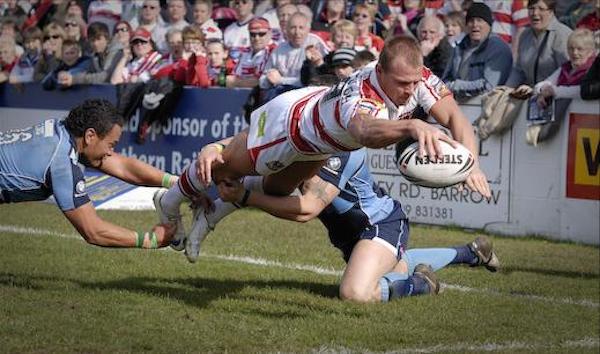Dear Sports Fan,
How does scoring work in rugby union?
Thanks,
Clara
Dear Clara,
There are four ways to score in rugby, a try, a conversion goal, a penalty goal, and a dropped goal. A try is worth five points, a conversion goal, two, and both a penalty goal or dropped goal are worth three points. The three scoring methods with the word, “goal” in their names, all involve kicking the ball, while the try doesn’t. Two of them can happen in the course of normal play, while two are only done during a stoppage in play. Let’s go through each one and describe how it works.
How does a try work?
A try is scored when an attacking player with the ball places the ball on the ground in her opponent’s “in-goal.” The in-goal is rugby’s term for the area that in American football is called the end-zone. As opposed to in American football, where a player just needs to have control of the ball in the end-zone to score, in rugby, a player must get the ball into the end zone and place it on the ground. Two other small matters distinguish how a try works from how a touchdown works in American football. In rugby, a player’s body can be out-of-bounds and still score as long as the ball remains in play. Likewise, a player can be lying on the ground and reach his arm out to score a try. A try is worth five points and triggers the second form of scoring, the conversion goal.
How does a conversion goal work?
A conversion goal attempt is earned by scoring a try. After a team scores a try, they are given 90 seconds to attempt a conversion goal. A conversion goal is a mostly undefended kick that must go over the cross-bar and between the two goal posts of the rugby goal. I say, “mostly undefended” because the defending team is allowed to run, from the goal-line, toward the player kicking the ball, as soon as that player starts their kicking motion. The kick may be taken as a drop-kick (kind of like a punt in football, but the ball must be kicked as it hits the ground instead of while it’s on its way down) or from the ground, where the ball may be supported by a tee or a teammate to keep it upright and in position. The player who scored the try doesn’t have to be the one to take the conversion kick. Any player on the team is eligible to kick it.
The location of the dropkick is decided by where the try was scored. The conversion goal must be attempted from a spot “perpendicular” to where the try was scored. That means, if the try was scored in the exact center of the field, the conversion goal must be kicked from the center. If the try was scored all the way on the left edge of the field, the conversion must also be taken from the far left. The closer to center a conversion goal attempt is, the easier it is to score. That’s why you’ll sometimes see players try to run to the center before placing the ball on the ground for a try. As for the distance from the goal, there’s no requirement at all. In practice, the kicker chooses a distance that is far enough from the goal so that she feels comfortable she’ll be able to get the kick off free from interference by the other team. The farther the kick is from the center of the field, the more difficult it is to make. In order to get a reasonable angle from that wide, the kicker will generally move back a bit.
A conversion goal is worth two points and may only be taken directly after a try. There are two other forms of scoring. Both are similar to a conversion goal but do not follow a try.
How do a penalty goal and a dropped goal work?
A penalty goal is procedurally similar to a conversion goal, with the only real difference being that a player may not use a drop-kick to score a penalty goal. A penalty goal attempt is awarded to a team when the opposing team commits a foul. It is similar to a free kick set piece in soccer. The ref blows her whistle to call a foul, the opposing team must move ten yards away from the spot of the foul, and then the team benefiting from the penalty call can choose what to do. If the spot of the foul is close enough to reasonably score a goal and the game situation calls for it, they may choose to attempt a kick through the uprights. A successful penalty goal is worth three points.
A dropped goal is the active cousin of a penalty goal. Instead of happening when play is stopped, a dropped goal happens during active play. Whenever a player has possession of the ball, they always have the option of drop-kicking the ball through the goal. If they are able to do this successfully, their team scores three points. You’d think this might happen more frequently than it does, but going for a dropped goal means giving up the opportunity to score seven points (a five point try and a two point conversion goal), and giving possession of the ball to the other team. When a dropped goal is successful, the other team automatically gets the ball. When a dropped goal is unsuccessful (the ball misses the goal wide or isn’t high enough), play continues and whoever can get to the ball first (usually the defensive team) takes possession of it.
Thanks for reading,
Ezra Fischer

